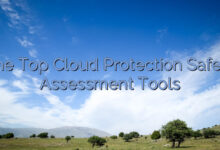Conducting a Cloud Safety Risk Assessment: Best Practices
Are you considering migrating your data to the cloud, but concerned about the safety risks? Conducting a cloud safety risk assessment is an essential step before adopting any cloud environment. In this article, we’ll dive into best practices for conducting a cloud safety risk assessment to help you make an informed decision that benefits your organization.
Contents
- 1 📌 Introduction
- 1.1 📌 What is a Cloud Safety Risk Assessment?
- 1.2 📌 Why is it Important to Conduct a Cloud Safety Risk Assessment?
- 1.3 📌 Best Practices for Conducting a Cloud Safety Risk Assessment
- 1.3.1 🔎 1. Identify and Evaluate Potential Security Risks:
- 1.3.2 🔎 2. Evaluate Cloud Service Providers:
- 1.3.3 🔎 3. Analyze the Cloud Environment:
- 1.3.4 🔎 4. Consider Regulatory Compliance:
- 1.3.5 🔎 5. Develop an Incident Response Plan:
- 1.3.6 🔎 6. Implement Security Measures:
- 1.3.7 🔎 7. Conduct Regular Risk Assessments:
- 1.4 📌 Strengths and Weaknesses of Conducting a Cloud Safety Risk Assessment: Best Practices
- 1.5 📌 Table: Conducting a Cloud Safety Risk Assessment
- 1.6 📌 FAQs about Cloud Safety Risk Assessment
- 1.6.1 🔎 1. What is Cloud Safety Risk Assessment?
- 1.6.2 🔎 2. Why is a Cloud Safety Risk Assessment Important?
- 1.6.3 🔎 3. What are the best practices for conducting a cloud safety risk assessment?
- 1.6.4 🔎 4. What are the risks associated with not conducting a cloud safety risk assessment?
- 1.6.5 🔎 5. How often should you conduct a cloud safety risk assessment?
- 1.6.6 🔎 6. How can you evaluate cloud service providers?
- 1.6.7 🔎 7. What are the critical regulatory requirements to consider when conducting a cloud safety risk assessment?
- 1.6.8 🔎 8. What is an incident response plan?
- 1.6.9 🔎 9. What security measures can you implement to reduce the risk of a data breach?
- 1.6.10 🔎 10. What is the purpose of regular cloud safety risk assessments?
- 1.6.11 🔎 11. Who should conduct a cloud safety risk assessment?
- 1.6.12 🔎 12. How long does a cloud safety risk assessment take?
- 1.6.13 🔎 13. What is the approximate cost of conducting a cloud safety risk assessment?
- 1.7 📌 Conclusion
- 1.8 📌 Disclaimer
📌 Introduction
Hello, Visitors! In today’s digital world, most organizations rely heavily on cloud platforms to store, process, and manage their data. The cloud offers businesses flexibility, scalability, and accessibility like no other platform. However, it comes with security risks that can be a potential threat to organizational data. Therefore, conducting a cloud safety risk assessment is crucial to identifying potential risks before migrating to the cloud. In this article, we’ll guide you through best practices for conducting a cloud safety risk assessment to ensure the safety of your data.
📌 What is a Cloud Safety Risk Assessment?
A Cloud safety risk assessment is a comprehensive process of evaluating potential safety risks associated with the cloud infrastructure and identifying ways to mitigate them. The main objective of a Cloud safety risk assessment is to identify potential safety breaches that can lead to data loss, data breaches, fines, litigation, and reputational damage. Therefore, it is crucial to conduct a risk assessment before deploying any cloud solution.
📌 Why is it Important to Conduct a Cloud Safety Risk Assessment?
Conducting a cloud safety risk assessment is important as it helps organizations evaluate, identify, and mitigate potential safety risks associated with the cloud. The assessment process identifies the gaps in the security posture and provides recommendations to enhance the security posture. By conducting a cloud safety risk assessment, organizations can ensure the safety of their data and maintain the trust and reputation of their customers.
📌 Best Practices for Conducting a Cloud Safety Risk Assessment
🔎 1. Identify and Evaluate Potential Security Risks:
The first step in conducting a cloud safety risk assessment is identifying potential security risks. Identify the different types of data, including Structured, Semi-Structured, and Unstructured data, that your organization handles. Knowing the type of data you handle will help you identify potential vulnerabilities in the cloud environment.
You should also identify who has access to the data, including employees, vendors, contractors, and partners. Analyze how they access the data and information about their access management protocols. Understanding who has access to your data is crucial as it can help you determine the potential vulnerabilities in the system.
🔎 2. Evaluate Cloud Service Providers:
When conducting a cloud safety risk assessment, it is crucial to evaluate the cloud service providers. Ensure that the cloud provider you choose has a robust security posture in place. Review their security certifications, assessments, and audits to ensure compliance with industry standards as well as relevant regulations.
🔎 3. Analyze the Cloud Environment:
Conduct a comprehensive analysis of the cloud environment to evaluate the security risks associated with it. This analysis should include assessing the cloud provider’s infrastructure, data security protocols, encryption technologies, and access controls.
🔎 4. Consider Regulatory Compliance:
When evaluating cloud safety risks, it is vital to consider regulatory compliance. Each industry has different regulations and standards to ensure data privacy, such as HIPAA for healthcare and GDPR for the European Union. Understanding critical regulatory requirements can help you ensure adherence to relevant industry standards.
🔎 5. Develop an Incident Response Plan:
Develop an incident response plan to respond to emergency situations like a data breach or an unauthorized access attempt. The plan should outline the steps to take in the event of a security threat, how to isolate the breach, communication strategies, and remediation efforts to reduce the impact of the breach.
🔎 6. Implement Security Measures:
Implementing additional security measures, such as firewalls, intrusion detection systems, antivirus software, and multifactor authentication, can significantly reduce the risk of a data breach or compromise. These measures ensure that the cloud environment is secure and adequately managed.
🔎 7. Conduct Regular Risk Assessments:
Conduct regular cloud safety risk assessments to ensure that the environment is still secure and to identify any potential breaches or vulnerabilities. Ensuring that your cloud environment is safe requires continuous improvement, and assessing the cloud environment frequently can provide critical feedback on its effectiveness.
📌 Strengths and Weaknesses of Conducting a Cloud Safety Risk Assessment: Best Practices
🌟 Strengths:
The benefits of conducting a cloud safety risk assessment are manifold. It helps organizations identify potential risks, mitigate them, and develop a robust security posture against cyber threats. With the help of regular assessments, organizations can ensure the cloud environment’s security, reduce data breaches, and maintain the trust and reputation of their customers.
📌 Weaknesses:
Conducting a cloud safety risk assessment can be time-consuming and resource-intensive. It requires the expertise of skilled security professionals and extensive analysis of the cloud environment, which can increase the assessment cost.
📌 Table: Conducting a Cloud Safety Risk Assessment
| Steps | Description |
|---|---|
| Identify and Evaluate Potential Security Risks | Identify different types of data your organization handles and evaluate who has access to it. |
| Evaluate Cloud Service Providers | Evaluate the cloud service providers to ensure compliance with industry standards. |
| Analyze the Cloud Environment | Conduct a comprehensive analysis of the cloud environment to identify potential security risks. |
| Consider Regulatory Compliance | Evaluate regulatory compliance and ensure adherence to industry standards and regulations. |
| Develop an Incident Response Plan | Create an incident response plan to respond to security threats effectively. |
| Implement Security Measures | Deploy additional security measures to reduce the risk of a data breach or compromise. |
| Conduct Regular Risk Assessments | Conduct frequent cloud safety risk assessments to improve the security environment’s effectiveness. |
📌 FAQs about Cloud Safety Risk Assessment
🔎 1. What is Cloud Safety Risk Assessment?
A cloud safety risk assessment is a process of evaluating potential safety risks associated with the cloud infrastructure and identifying ways to mitigate them.
🔎 2. Why is a Cloud Safety Risk Assessment Important?
A cloud safety risk assessment is important as it helps identify potential safety breaches and enhances the security posture.
🔎 3. What are the best practices for conducting a cloud safety risk assessment?
The best practices for conducting a cloud safety risk assessment include identifying and evaluating potential security risks, analyzing the cloud environment, and implementing security measures.
🔎 4. What are the risks associated with not conducting a cloud safety risk assessment?
Not conducting a cloud safety risk assessment can lead to data breaches, fines, litigation, and reputational damage.
🔎 5. How often should you conduct a cloud safety risk assessment?
Conducting regular cloud safety risk assessments is recommended to ensure that the environment is still secure and identify any potential vulnerabilities.
🔎 6. How can you evaluate cloud service providers?
You can evaluate cloud service providers by reviewing their security certifications, audits, and assessments to ensure compliance with industry standards and regulations.
🔎 7. What are the critical regulatory requirements to consider when conducting a cloud safety risk assessment?
Regulatory requirements are different for each industry. HIPAA for healthcare and GDPR for the European Union are two examples of relevant regulations for specific industries.
🔎 8. What is an incident response plan?
Incident response plan is a documented process developed to respond quickly and efficiently to cybersecurity incidents.
🔎 9. What security measures can you implement to reduce the risk of a data breach?
You can deploy firewalls, intrusion detection systems, antivirus software, and multifactor authentication to reduce the risk of a data breach or compromise.
🔎 10. What is the purpose of regular cloud safety risk assessments?
Regular cloud safety risk assessments help organizations ensure that the environment is still secure and identify potential breaches or vulnerabilities.
🔎 11. Who should conduct a cloud safety risk assessment?
Professional security consultants who possess extensive knowledge and expertise in cloud security should conduct cloud safety risk assessments.
🔎 12. How long does a cloud safety risk assessment take?
The duration of a cloud safety risk assessment depends on the organization’s size, nature, and complexity of cloud infrastructure. It can take weeks or months.
🔎 13. What is the approximate cost of conducting a cloud safety risk assessment?
The cost of a cloud safety risk assessment varies depending on the cloud infrastructure’s size, nature, complexity, and the experience and expertise of the security consultant conducting the assessment.
📌 Conclusion
In conclusion, Conducting a cloud safety risk assessment should be an integral part of the organization’s cloud strategy. A thorough cloud safety risk assessment can help identify potential security breaches, mitigate them, and improve the security posture. It’s essential to consider best practices and regulatory compliance standards when conducting a cloud safety risk assessment. Remember to plan for the future and conduct regular assessments to enhance your cloud environment’s security.
📌 Disclaimer
The material and information contained in this article are for educational and informational purposes only and do not constitute professional advice. It is your responsibility to evaluate the accuracy, completeness, and usefulness of any opinions, advice, services, or other information provided in this article.







